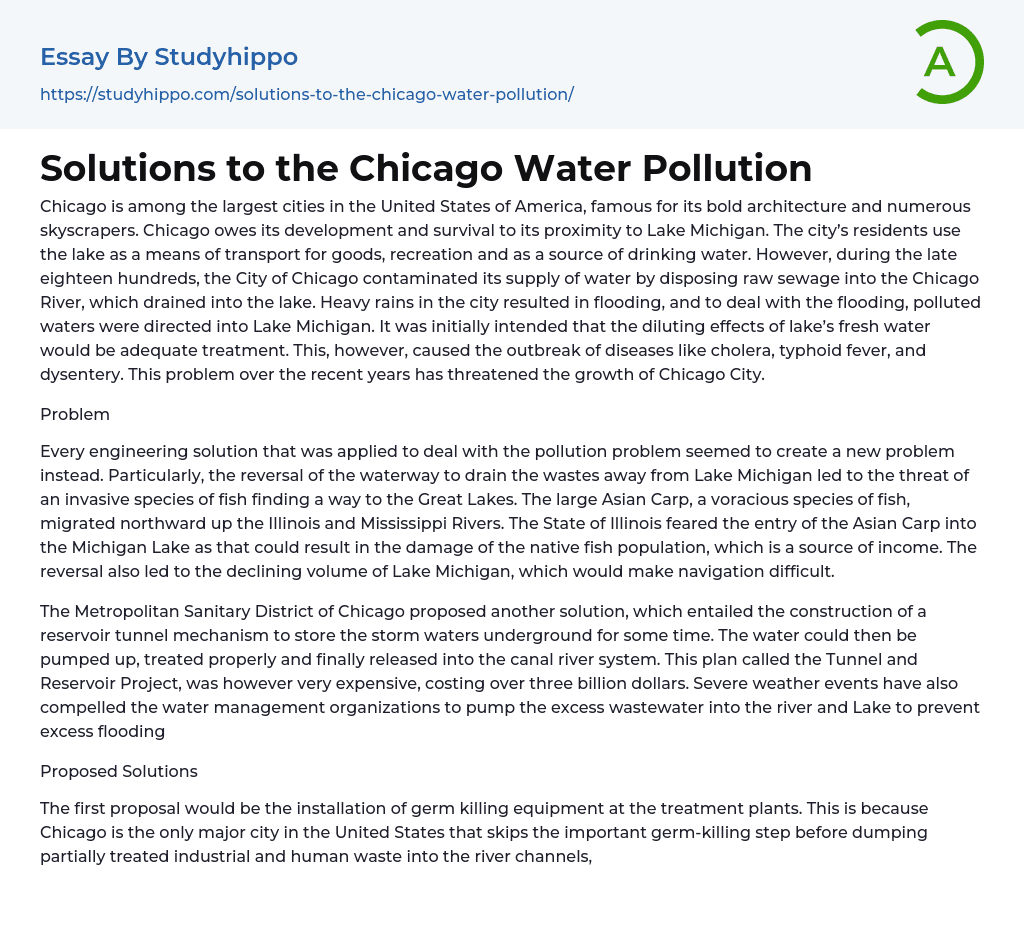Chicago is among the largest cities in the United States of America, famous for its bold architecture and numerous skyscrapers. Chicago owes its development and survival to its proximity to Lake Michigan. The city’s residents use the lake as a means of transport for goods, recreation and as a source of drinking water. However, during the late eighteen hundreds, the City of Chicago contaminated its supply of water by disposing raw sewage into the Chicago River, which drained into the lake. Heavy rains in the city resulted in flooding, and to deal with the flooding, polluted waters were directed into Lake Michigan. It was initially intended that the diluting effects of lake’s fresh water would be adequate treatment. This, however, caused the outbreak of diseases like cholera, typhoid fever, and dysentery. This problem over the recent years has thr
...eatened the growth of Chicago City.
Problem
Every engineering solution that was applied to deal with the pollution problem seemed to create a new problem instead. Particularly, the reversal of the waterway to drain the wastes away from Lake Michigan led to the threat of an invasive species of fish finding a way to the Great Lakes. The large Asian Carp, a voracious species of fish, migrated northward up the Illinois and Mississippi Rivers. The State of Illinois feared the entry of the Asian Carp into the Michigan Lake as that could result in the damage of the native fish population, which is a source of income. The reversal also led to the declining volume of Lake Michigan, which would make navigation difficult.
The Metropolitan Sanitary District of Chicago proposed another solution, which entailed the construction of a reservoir tunnel
mechanism to store the storm waters underground for some time. The water could then be pumped up, treated properly and finally released into the canal river system. This plan called the Tunnel and Reservoir Project, was however very expensive, costing over three billion dollars. Severe weather events have also compelled the water management organizations to pump the excess wastewater into the river and Lake to prevent excess flooding
Proposed Solutions
The first proposal would be the installation of germ killing equipment at the treatment plants. This is because Chicago is the only major city in the United States that skips the important germ-killing step before dumping partially treated industrial and human waste into the river channels, with the assumption that people would not want to come near the river.
It is also important to incentivize ranchers and farmers to amend their agricultural practices. This would entail plant cover crops to protect the soil, reduce the amount of run-off from excess fertilizers and replanting trees to mitigate sedimentation. This act could potentially cut down the amount of nutrient pollution reaching Chicago’s water system by a greater percentage. The farmers should also test the soils before applying fertilizers. Sensitizing on the restoration and protection of forests would ensure clean and regulate the water flow. This would thus entail repairing the riverbanks to mitigate erosion. The remains from the battered soil conceal the habitat of the water through for instance blocking the fish gills and shipping in excess nutrients into the river. Besides, reparation of the forestland in the watershed would prevent nutrients from entering Lake Michigan and causing degradation in the water supply.
One of the solutions often forgone by engineers
is educating the public on the perils of dumping hazardous chemicals improperly. People have to be familiarized with the fact that flushing pills, drugs or powder medications down the drain is one of the main causes of water pollution. The public should also be educated on the importance of re-using and re-cycling. This greatly cuts down on the amount. In essence, starting of a compost pile to decompose food waste and turn it into fertilizer is imperative for home gardens instead of chemical fertilizers that cause pollution if improperly used. Other small deeds like using a re-usable water bottle instead of a disposable one, not washing cars on the driveway but the lawn, recycling used motor oil, reducing auto-emissions from vehicles cumulatively cut down on the amount of pollution in the City of Chicago.
The city of Chicago should embrace usage of renewable sources of energy. Solar energy, for example, could be quite appropriate considering the City of Chicago has numerous flat rooftops on industrial, commercial and residential buildings. The Illinois Commerce Commission should also involve itself in the matter by for instance adopting policies that allows the community solar projects for residents and local businesses to embrace clean sources of energy. To stop the invasive species of fish threatening the population of the native fish, the Great Lakes should be separated from the Mississippi River. These solutions could collectively improve the quality of water for many people in the city while at the same time reducing the annual costs for water treatment. Chicago City could see a positive return from investing in water conservation such as improved recreation and much healthier ecosystems.
Work Cited
- "Chicago Portage".
Digitalcollections.Library.Cmu.Edu. Last modified 2016. Accessed November 6, 2016. https://digitalcollections.library.cmu.edu/portal/collections/chicago/history_site.jsp.
- Animal Welfare essays
- Zoo essays
- Plastic essays
- Waste Management essays
- Climate Change essays
- Global Warming essays
- Conservation essays
- Recycling essays
- Air Pollution essays
- Carbon Dioxide essays
- Climate essays
- Deforestation essays
- Ecology essays
- Endangered Species essays
- Environmental Issues essays
- Environmental Protection essays
- flood essays
- Greenhouse Gas essays
- Hurricane essays
- Nature essays
- Pollution essays
- Renewable Energy essays
- Sustainability essays
- Tornado essays
- Traffic essays
- Tsunami essays
- Water Pollution essays




